.gif)
Branch (bridle)
Encyclopedia
The bit shank is the side piece or cheekpiece of a curb bit
, part of the bridle
, used when riding
on horse
s. The bit shank allows leverage to be added to the pressure of the rider's hands
on the bit
. Shanks are usually made of metal, may be straight or curved, and may be decorated in some disciplines. The headstall and curb chain
or curb strap of the bridle is attached to the top of the shank, and the rein
s are attached at the bottom. Shanked curb bits are used in western riding
for nearly all adult horses, and are seen in English riding
disciplines primarily as part of the double bridle
used by advanced Dressage
riders, and on the hybrid Pelham bit
that includes a ring for a second rein attached at the bit mouthpiece
.
Direct pressure snaffle bits have no shanks, instead they have a single bit ring
.
Bit
s that have shanks coming off the mouthpiece
create lever
age and place pressure on the poll via the crownpiece of the bridle
, to the chin groove via the curb chain
, and, especially with a "loose jaw" shank, may also touch the sides of the mouth and jaw. The shank and its leverage action is what defines a curb bit as a curb, regardless of mouthpiece. Though most curb bits have a solid mouthpiece, with or without a port, any bit with shanks and leverage is always a "curb" type bit, even if has a jointed mouthpiece. Shanked bits in the curb family include the Weymouth, which is the curb portion of the double bridle
; the pelham bit
, a single bit ridden with two sets of reins; and the single-reined curb bit
.
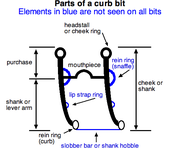
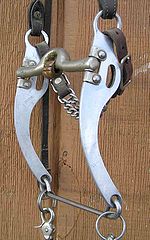 The term shank is generally used interchangeably with the term "cheek" to describe the entire sidepiece of the bit, but shank also may refer just to the lever arm, the portion of the bit that extends from the mouthpiece to the rein ring. The purchase of the bit is the upper portion of the cheek that extends from the mouthpiece to the headstall rings. All shanks have a rein ring at the bottom for the curb rein and a cheek ring at the top to attach the headstall. Some shanks may also add rings or slots to attach a snaffle rein at the mouthpiece, allowing the bit to be used with two sets of reins, making it a pelham bit
The term shank is generally used interchangeably with the term "cheek" to describe the entire sidepiece of the bit, but shank also may refer just to the lever arm, the portion of the bit that extends from the mouthpiece to the rein ring. The purchase of the bit is the upper portion of the cheek that extends from the mouthpiece to the headstall rings. All shanks have a rein ring at the bottom for the curb rein and a cheek ring at the top to attach the headstall. Some shanks may also add rings or slots to attach a snaffle rein at the mouthpiece, allowing the bit to be used with two sets of reins, making it a pelham bit
.
Some shanks, especially on the Weymouth, have small rings placed midway down the shank to attach a lip strap, a helpful addition to the bit for preventing a horse from grabbing at the shanks with its lips. Some shanks on western-style
bits are "hobbled" together by a metal bar (sometimes called a "slobber bar" because saliva from the horse's mouth can drop onto it) or even a piece of leather, which has the dual effect of keeping anything from getting wrapped around the shank, such as a lariat
, and can limit excessive motion in a loose-jawed shank.
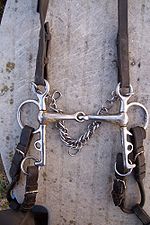 The length of the shank determines the degree of lever
The length of the shank determines the degree of lever
age put on the horse's head and mouth. The leverage ratio for a typical curb bit is 1:4 (where the ratio of upper and lower cheek is 1:3), in that one ounce of pressure by the rider will result in four ounces of pressure on the mouth of the horse. Overall cheek length, from the top of the cheek ring to the bottom of the rein ring, usually cannot exceed 8½ inches for most western horse show
disciplines. In Dressage
the length of the lever arm portion of the cheek cannot exceed 10 cm. Cheek sizes vary from the Tom Thumb (about 4½ inches long) to bits that exceed the 8½ inch "show legal" maximum cheek length.
The relative ratio between the length of the purchase and the lever arm also affects the amount and type of leverage that is applied to the chin and poll of the horse (producing 1:3 ratio of rein to chin+poll forces in case of the typical curb bit). A long lower shank (lever arm) in relation to the upper shank (purchase) increases the leverage, and thus the pressure, on the curb groove and the bars of the mouth. This design is best suited for a longer-necked horse, as it encourages the horse to both drop its head down and bring its nose in. A somewhat long upper shank in relation to the lower shank increases the pressure on the poll, but does not apply as much pressure on the bars of the mouth. This design is often more helpful on a horse with a short and thick neck, as it encourages the horse to drop its head, but with less pressure to flex the nose in, an act that is physically more difficult for a horse with a thick neck.
Overall, a shorter-shanked bit is usually a milder bit, but also responds quickly when the rider touches the reins. Short shanked bits are usually better for a young horse transitioning from a snaffle to a curb because if the inexperienced horse gets into a place where bit pressure from the rider's hands becomes significant, there is less leverage pressure placed on the horse's head.
However, as the horse becomes more polished in its training, a somewhat longer shanked bit is preferred for its subtlety. Longer shanked bits must rotate back further before applying pressure on the horse's mouth than shorter-shanked bits. Therefore, the horse has more "warning" of a rider's hand movements in a long-shanked bit, allowing it to respond before any significant pressure is applied to its mouth. In this way, a longer shank (up to a point) can allow quieter communication between a well-trained horse and a rider with soft hands, without increasing severity of the mouthpiece.
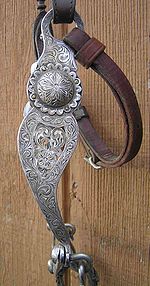 A fixed shank, common shank length, show-legal]]
A fixed shank, common shank length, show-legal]]
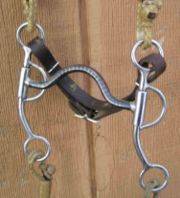 Shanks come in a variety of types, which may affect the action of the bit. Some shanks are loose-jawed, meaning they swivel at the point where the mouthpiece attaches to the shank. Others have a fixed shank that does not move. Some shanks have a loose, rotating ring for rein attachment, others have a solid, fixed ring molded into the shank itself.
Shanks come in a variety of types, which may affect the action of the bit. Some shanks are loose-jawed, meaning they swivel at the point where the mouthpiece attaches to the shank. Others have a fixed shank that does not move. Some shanks have a loose, rotating ring for rein attachment, others have a solid, fixed ring molded into the shank itself.
Any moving parts on a shank that allow slight movement in the shanks before the bit engages provide a "warning" to the horse, allowing it to respond to lighter pressure, thus allowing more subtle communication between horse and rider when on a loose rein or when introducing a young horse to curb pressure.
The cheek-to-shank angle also varies, with some straight up and down, others with the shanks curving backward. Some shanks have a dramatic S-curve. Cheek angle influences the angle at which the bit engages and thus way the horse carries its head. Therefore, the type of shank needs to be considered according to the use of the horse. Horses that maintain a more vertical head position, such as dressage horses and western horses trained in the "straight up" or Vaquero
tradition generally use a curb bit with straighter shanks. Those that have a nose-out head position when working, such as cutting
and roping
horses, more commonly use a more curved shank. Shanks on certain western bits that curve back are sometimes called a "grazing bit." Though a horse should never be allowed to graze in a bridle, the term came from the mistaken notion that the turned-back shank was to allow the horse to eat with a bridle. In reality, the design simply allowed the horse to comfortably travel with its nose well ahead of the vertical. An S curve in a shank does not have a major effect on the angle at which the rein engages, but may alter the balance of the bit at the point the lever arm joins the mouthpiece.
, the underlying classicical principles are still applicable today:
Curb bit
A curb bit is a type of bit used for riding horses that uses lever action. It includes the pelham bit and the Weymouth curb along with the traditional "curb bit" used mainly by Western riders....
, part of the bridle
Bridle
A bridle is a piece of equipment used to direct a horse. As defined in the Oxford English Dictionary, the "bridle" includes both the headstall that holds a bit that goes in the mouth of a horse, and the reins that are attached to the bit....
, used when riding
Equestrianism
Equestrianism more often known as riding, horseback riding or horse riding refers to the skill of riding, driving, or vaulting with horses...
on horse
Horse
The horse is one of two extant subspecies of Equus ferus, or the wild horse. It is a single-hooved mammal belonging to the taxonomic family Equidae. The horse has evolved over the past 45 to 55 million years from a small multi-toed creature into the large, single-toed animal of today...
s. The bit shank allows leverage to be added to the pressure of the rider's hands
Riding aids
Riding aids are the cues a rider gives to a horse to communicate what they want the animal to do. Riding aids are broken into the natural aids and the artificial aids.-Natural aids:...
on the bit
Bit (horse)
A bit is a type of horse tack used in equestrian activities, usually made of metal or a synthetic material, and is placed in the mouth of a horse or other equid and assists a rider in communicating with the animal. It rests on the bars of the mouth in an interdental region where there are no teeth...
. Shanks are usually made of metal, may be straight or curved, and may be decorated in some disciplines. The headstall and curb chain
Curb chain
A curb chain, or curb strap, is a piece of horse tack used on any type of curb bit. It is a flat linked chain or strap that runs under the chin groove of the horse, between the bit shank purchase arms. It has a buckle or hook attachment and often has a "fly link" in the middle to apply a lip strap...
or curb strap of the bridle is attached to the top of the shank, and the rein
Rein
Reins are items of horse tack, used to direct a horse or other animal used for riding or driving. Reins can be made of leather, nylon, metal, or other materials, and attach to a bridle via either its bit or its noseband.-Use for riding:...
s are attached at the bottom. Shanked curb bits are used in western riding
Western riding
Western riding is a style of horseback riding which evolved from the ranching and warfare traditions brought to the Americas by the Spanish Conquistadors, and both equipment and riding style evolved to meet the working needs of the cowboy in the American West...
for nearly all adult horses, and are seen in English riding
English riding
English riding is a term used to describe a form of horse riding that is seen throughout the world. There are many variations in English riding, but all feature a flat English saddle without the deep seat, high cantle or saddle horn seen on a Western saddle nor the knee pads seen on an Australian...
disciplines primarily as part of the double bridle
Double bridle
A double bridle, also called a full bridle or Weymouth bridle, is a bridle that has two bits and four reins . One bit is the bradoon , is a modified snaffle bit that is smaller in diameter and has smaller bit rings than a traditional snaffle, and it is adjusted so that it sits above and behind the...
used by advanced Dressage
Dressage
Dressage is a competitive equestrian sport, defined by the International Equestrian Federation as "the highest expression of horse training." Competitions are held at all levels from amateur to the World Equestrian Games...
riders, and on the hybrid Pelham bit
Pelham bit
A pelham bit is a type of bit used when riding a horse. It has elements of both a curb bit and a snaffle bit. In this respect a pelham bit functions similar to a double bridle, and like a double bridle it normally has "double" reins: a set of curb reins and a set of snaffle reins. Because it has...
that includes a ring for a second rein attached at the bit mouthpiece
Bit mouthpiece
The mouthpiece is the part of a horse's bit that goes into the mouth of a horse, resting on the bars of the mouth in the sensitive interdental space where there are no teeth. The mouthpiece is possibly the most important determinant in the severity and action of the bit. Therefore, it should be...
.
Direct pressure snaffle bits have no shanks, instead they have a single bit ring
Bit ring
The bit ring is the ring on the side of a horse's bit, particularly on a snaffle bit. It is used as a point of attachment for the cheekpieces of the bridle and for the reins. It also has an effect on the action of the bit...
.
Bit
Bit (horse)
A bit is a type of horse tack used in equestrian activities, usually made of metal or a synthetic material, and is placed in the mouth of a horse or other equid and assists a rider in communicating with the animal. It rests on the bars of the mouth in an interdental region where there are no teeth...
s that have shanks coming off the mouthpiece
Bit mouthpiece
The mouthpiece is the part of a horse's bit that goes into the mouth of a horse, resting on the bars of the mouth in the sensitive interdental space where there are no teeth. The mouthpiece is possibly the most important determinant in the severity and action of the bit. Therefore, it should be...
create lever
Lever
In physics, a lever is a rigid object that is used with an appropriate fulcrum or pivot point to either multiply the mechanical force that can be applied to another object or resistance force , or multiply the distance and speed at which the opposite end of the rigid object travels.This leverage...
age and place pressure on the poll via the crownpiece of the bridle
Bridle
A bridle is a piece of equipment used to direct a horse. As defined in the Oxford English Dictionary, the "bridle" includes both the headstall that holds a bit that goes in the mouth of a horse, and the reins that are attached to the bit....
, to the chin groove via the curb chain
Curb chain
A curb chain, or curb strap, is a piece of horse tack used on any type of curb bit. It is a flat linked chain or strap that runs under the chin groove of the horse, between the bit shank purchase arms. It has a buckle or hook attachment and often has a "fly link" in the middle to apply a lip strap...
, and, especially with a "loose jaw" shank, may also touch the sides of the mouth and jaw. The shank and its leverage action is what defines a curb bit as a curb, regardless of mouthpiece. Though most curb bits have a solid mouthpiece, with or without a port, any bit with shanks and leverage is always a "curb" type bit, even if has a jointed mouthpiece. Shanked bits in the curb family include the Weymouth, which is the curb portion of the double bridle
Double bridle
A double bridle, also called a full bridle or Weymouth bridle, is a bridle that has two bits and four reins . One bit is the bradoon , is a modified snaffle bit that is smaller in diameter and has smaller bit rings than a traditional snaffle, and it is adjusted so that it sits above and behind the...
; the pelham bit
Pelham bit
A pelham bit is a type of bit used when riding a horse. It has elements of both a curb bit and a snaffle bit. In this respect a pelham bit functions similar to a double bridle, and like a double bridle it normally has "double" reins: a set of curb reins and a set of snaffle reins. Because it has...
, a single bit ridden with two sets of reins; and the single-reined curb bit
Curb bit
A curb bit is a type of bit used for riding horses that uses lever action. It includes the pelham bit and the Weymouth curb along with the traditional "curb bit" used mainly by Western riders....
.
Parts of the shank


Pelham bit
A pelham bit is a type of bit used when riding a horse. It has elements of both a curb bit and a snaffle bit. In this respect a pelham bit functions similar to a double bridle, and like a double bridle it normally has "double" reins: a set of curb reins and a set of snaffle reins. Because it has...
.
Some shanks, especially on the Weymouth, have small rings placed midway down the shank to attach a lip strap, a helpful addition to the bit for preventing a horse from grabbing at the shanks with its lips. Some shanks on western-style
Western riding
Western riding is a style of horseback riding which evolved from the ranching and warfare traditions brought to the Americas by the Spanish Conquistadors, and both equipment and riding style evolved to meet the working needs of the cowboy in the American West...
bits are "hobbled" together by a metal bar (sometimes called a "slobber bar" because saliva from the horse's mouth can drop onto it) or even a piece of leather, which has the dual effect of keeping anything from getting wrapped around the shank, such as a lariat
Lariat
Lariat can refer to:*A rope in the form of a lasso*Lariat chain, a science demonstration*A professional wrestling move, a variation of a clothesline*A genetic structure in Splicing *Double Lariat, a popular song sung by Luka Megurine...
, and can limit excessive motion in a loose-jawed shank.
Length and leverage

Lever
In physics, a lever is a rigid object that is used with an appropriate fulcrum or pivot point to either multiply the mechanical force that can be applied to another object or resistance force , or multiply the distance and speed at which the opposite end of the rigid object travels.This leverage...
age put on the horse's head and mouth. The leverage ratio for a typical curb bit is 1:4 (where the ratio of upper and lower cheek is 1:3), in that one ounce of pressure by the rider will result in four ounces of pressure on the mouth of the horse. Overall cheek length, from the top of the cheek ring to the bottom of the rein ring, usually cannot exceed 8½ inches for most western horse show
Horse show
A Horse show is a judged exhibition of horses and ponies. Many different horse breeds and equestrian disciplines hold competitions worldwide, from local to the international levels. Most horse shows run from one to three days, sometimes longer for major, all-breed events or national and...
disciplines. In Dressage
Dressage
Dressage is a competitive equestrian sport, defined by the International Equestrian Federation as "the highest expression of horse training." Competitions are held at all levels from amateur to the World Equestrian Games...
the length of the lever arm portion of the cheek cannot exceed 10 cm. Cheek sizes vary from the Tom Thumb (about 4½ inches long) to bits that exceed the 8½ inch "show legal" maximum cheek length.
The relative ratio between the length of the purchase and the lever arm also affects the amount and type of leverage that is applied to the chin and poll of the horse (producing 1:3 ratio of rein to chin+poll forces in case of the typical curb bit). A long lower shank (lever arm) in relation to the upper shank (purchase) increases the leverage, and thus the pressure, on the curb groove and the bars of the mouth. This design is best suited for a longer-necked horse, as it encourages the horse to both drop its head down and bring its nose in. A somewhat long upper shank in relation to the lower shank increases the pressure on the poll, but does not apply as much pressure on the bars of the mouth. This design is often more helpful on a horse with a short and thick neck, as it encourages the horse to drop its head, but with less pressure to flex the nose in, an act that is physically more difficult for a horse with a thick neck.
Overall, a shorter-shanked bit is usually a milder bit, but also responds quickly when the rider touches the reins. Short shanked bits are usually better for a young horse transitioning from a snaffle to a curb because if the inexperienced horse gets into a place where bit pressure from the rider's hands becomes significant, there is less leverage pressure placed on the horse's head.
However, as the horse becomes more polished in its training, a somewhat longer shanked bit is preferred for its subtlety. Longer shanked bits must rotate back further before applying pressure on the horse's mouth than shorter-shanked bits. Therefore, the horse has more "warning" of a rider's hand movements in a long-shanked bit, allowing it to respond before any significant pressure is applied to its mouth. In this way, a longer shank (up to a point) can allow quieter communication between a well-trained horse and a rider with soft hands, without increasing severity of the mouthpiece.
Shank designs


Any moving parts on a shank that allow slight movement in the shanks before the bit engages provide a "warning" to the horse, allowing it to respond to lighter pressure, thus allowing more subtle communication between horse and rider when on a loose rein or when introducing a young horse to curb pressure.
The cheek-to-shank angle also varies, with some straight up and down, others with the shanks curving backward. Some shanks have a dramatic S-curve. Cheek angle influences the angle at which the bit engages and thus way the horse carries its head. Therefore, the type of shank needs to be considered according to the use of the horse. Horses that maintain a more vertical head position, such as dressage horses and western horses trained in the "straight up" or Vaquero
Cowboy
A cowboy is an animal herder who tends cattle on ranches in North America, traditionally on horseback, and often performs a multitude of other ranch-related tasks. The historic American cowboy of the late 19th century arose from the vaquero traditions of northern Mexico and became a figure of...
tradition generally use a curb bit with straighter shanks. Those that have a nose-out head position when working, such as cutting
Cutting (sport)
Cutting is an equestrian event in the western riding style where a horse and rider are judged on their ability to separate a single animal away from a cattle herd and keep it away for a short period of time.-Description:...
and roping
Team roping
Team roping also known as heading and heeling is a rodeo event that features a steer and two mounted riders. The first roper is referred to as the "header," the person who ropes the front of the steer, usually around the horns, but it is also legal for the rope to go around the neck, or go around...
horses, more commonly use a more curved shank. Shanks on certain western bits that curve back are sometimes called a "grazing bit." Though a horse should never be allowed to graze in a bridle, the term came from the mistaken notion that the turned-back shank was to allow the horse to eat with a bridle. In reality, the design simply allowed the horse to comfortably travel with its nose well ahead of the vertical. An S curve in a shank does not have a major effect on the angle at which the rein engages, but may alter the balance of the bit at the point the lever arm joins the mouthpiece.
Historical description
The Cyclopaedia of 1728 referred to shanks or cheeks as branches and described them as outlined in the paragraph below. Although the language is archaicArchaism
In language, an archaism is the use of a form of speech or writing that is no longer current. This can either be done deliberately or as part of a specific jargon or formula...
, the underlying classicical principles are still applicable today:
- The branches of a bridle, in the manage (i.e. a training arena-ed) of horses, are two crooked pieces of iron which support the mouth bit, the chain, and the curb, and which are fastened, on one side to the headstall, on the other to the reins, serving to keep the horse's head under command. Whichever way the branches of the bit incline, the horse's mouth always goes to the contrary.
- The branch is always to be accommodated to the design, either of bringing in, or raising a horse's head, and to the degree. Accordingly, there are strong and hardy branches, gentle branches, rude branches, etc. With regard to their form and structure, branches are either straight, in the form of a pistol, for young horses, to form their mouth; or, after the constable of France's fashion, for horses that already carry their head well, others are in the form of a gigotGigotGigot is an American motion picture; it was released in 1962 by 20th Century Fox. The film starred Jackie Gleason and was directed by Gene Kelly.-Synopsis:...
or leg; others of a bent knee; others in the French fashion, etc.
- Three laws traditionally used in the manage follow:
- That the farther the branch is from the horse's neck, the more effect it will have.
- That short branches,
Ceteris paribusor is a Latin phrase, literally translated as "with other things the same," or "all other things being equal or held constant." It is an example of an ablative absolute and is commonly rendered in English as "all other things being equal." A prediction, or a statement about causal or logical...
, are ruder, and their effects more sudden than those of others.- That the branch be proportioned to the length of the horse's neck.

